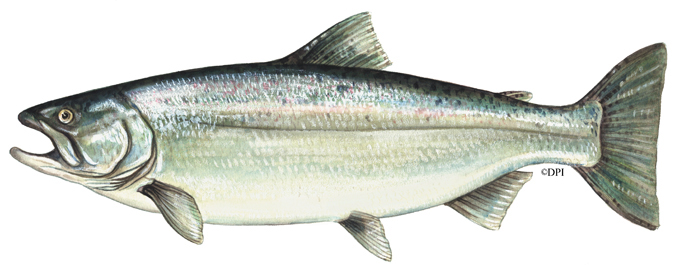Chinook salmon

| Common Name: | Chinook salmon |
| Other Name/s: | Quinnat salmon, King salmon, Spring salmon |
| Family: | Salmonidae |
| Scientific Name: | Oncorhynchus tshawytscha (Walbaum, 1792) |
| Origin: | Introduced |
| The classification of "introduced" reflects its translocation to Australia and Victoria, and this category is noted in the Flora and Fauna Guarantee Act 1988 (introduced to Australia after 1788 AD). | |
Description
Streamlined body, with conical head. Snout rather more pointed than other salmonids (brown trout, rainbow trout). Small eye, slightly oblique mouth extending well back behind the eye in adult fish. Mouth greatly deformed in ripe adult males, turned up at the tip and unable to be closed. Well developed teeth on both jaws. Small scales. Broad tail fin with pointed tips.
Predominantly silver, upper body colour is usually bluish green to olive, with lighter sides and silvery belly, although the entire body can be silvery on a freshly caught fish.
At least a few, and sometimes many small black spots on the back, and the top and tail fins. Eyes are usually olive to gold. Readily distinguished from other Victorian salmonids by the dusky grey-black colour inside the mouth alongside the teeth in the lower jaw.
Distribution
Principal populations in Victoria 1976-1995 were in Lakes Purrumbete and Bullen Merri (near Camperdown in south-western Victoria) until the total failure of the salmonid fishery in Lake Bullen Merri. Trial releases 1936-1983 into other lakes were not successful but stocking of Lake Modewarre and Lake Murdeduke have produced good results, particularly in the latter lake. Some fish stocked into Lake Purrumbete escape into the Curdies River but are rarely caught in that stream or its estuary. Some escapees from fish farms have been found in other Victorian streams, but no self-supporting populations have established.
Habitat
Natural habitat is the cool, fast-flowing streams of western North America and the ocean. In Victoria, initially in the two deep, cool, volcanic lakes mentioned, but the shallower Lake Murdeduke has supported good populations.
Brief Biology
Natural migratory stocks in North America have recorded fish of 1.6 metres and nearly 60 kg. Land-locked stocks in Victoria have been known to produce fish of 89 cm and 11.4 kg (Lake Bullen Merri, 1981), but fish in Victorian waters are generally smaller.
In natural circumstances, young and adult fish spend most of their life at sea, returning to their natal streams to spawn. Both males and females usually die after spawning. Mature, ripe males develop a very prominent hooked lower jaw, and colouring of both males and females darkens to black on some parts of the body. Body condition deteriorates markedly as spawning time nears.
Breeding in Victoria is by hatchery techniques of stripping eggs from ripe females and milt from ripe males, hatching and rearing the fish to a suitable size for release. Hatchery stock and released fish still retain the characteristic dying after spawning or attempted spawning.
Carnivorous, feeding on small fish such as galaxiids, crustaceans, molluscs and insects. Galaxiids are still abundant in Lake Bullen Merri even though the salmonid fishery has collapsed due to water quality. Galaxiids are now less abundant in Lake Purrumbete due to declining productivity of that lake and the combined predation impact of that lake's rainbow trout, chinook salmon and redfin population.
Management
Produced at the Department of Primary Industries' Snobs Creek Hatchery and several commercial fish farms and stocked into selected waters.
Other Notes
Native to North America, Chinook salmon were first introduced to Australia in the 1870's. Occasional importations of eyed eggs maintained some fishing in selected Victorian lakes until 1966, when ova importation was used to successfully establish a hatchery brood stock from which have come all subsequent releases in Victoria. This action was taken due to an impending ban (subsequently implemented) on the importation of live salmonid fish and eggs into Australia because of disease risks.
Regulations
Recreational Fishing Licence requirements and regulations affecting the taking of Chinook salmon in Victoria are available in the Victorian Recreational Fishing Guide, available free from RFL sales agents and DEDJTR Offices and Information Centres.
Further Reading
- A Guide to the Freshwater Fish of Victoria, Phillip Cadwallader & Gary Backhouse, Department of Conservation and Environment.
- Australian Freshwater Fishes, John R. Merrick & Gunther E. Schmida.
- Salmon at the Antipodes, John Clements.

